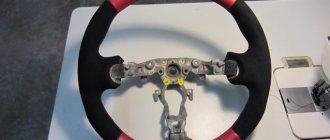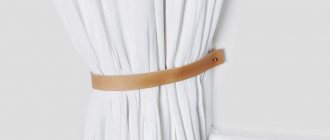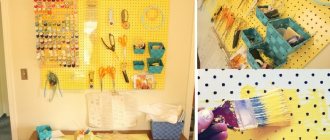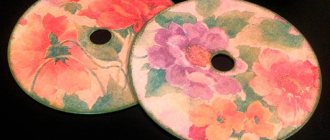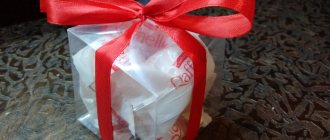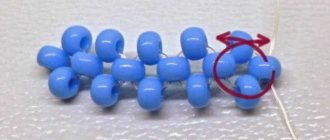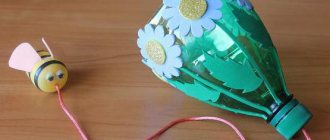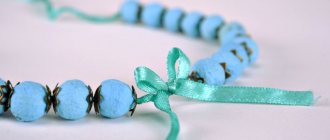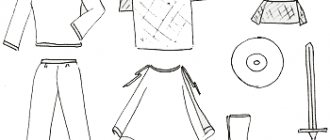Adviсe
Each area has its own little details and secrets.
Therefore, before starting work, it is worth studying the topic in detail. to give the cover softness and volume, you should add fleece and padding polyester; if you want the cover to close, you can glue magnets on both sides or a string; if you are using regular fabric, you should first starch it so that it holds its shape well; and of course, the most important rule not only in scrapbooking, but in creativity in general is accuracy, since in this matter sloppiness is simply unacceptable, everything should be as neat as possible; and what is important is desire, because something is worth doing only if you want it.
In conclusion, we invite you to watch a video about creating a stylish passport cover with flamingos.
How to correctly sign a student ID and grade book
In order to issue a student ID for all students, the dean’s office has to register the data of first-year students of the entire faculty. This takes a long time, and the wait for the document may last until November.
The easiest way is for students to fill out their details themselves. To do this, the dean’s office asks the entire group to remain in their places after the couples. Everyone is given ready-made student templates that need to be filled out by hand.
Each column indicates what needs to be written. Therefore, there should not be any difficulties.
In the last name column you need to write your full last name according to your passport
In the first and last name column you also need to write your passport details without abbreviations
In the department column you need to write as dictated by the headman or dean's office employee. In some cases, the name of the department may be too long and a common abbreviation may be used
In the form of study column, write how you study: “full-time/correspondence”
On the second page you must indicate the end date of the first year; it will be dictated by the headman or dean’s office employee.
This is where the student's authority ends. However, freshmen may also be asked to paste their own photos.
Thus, a student can make a student ID on his own. The dean's signature and the faculty seal will be affixed shortly.
Step-by-step instruction
So let's get to sewing.
Step 1: select materials and tools
First you need to choose a good piece of leather without defects (cuts, marks, holes, etc.).
Glue
To glue leather parts, you can use any waterproof plastic adhesives. You can use PVA glue. But the best glue is “Moment”. It is quite flexible and does not crack when the glued areas are bent - in general, it is ideal for gluing parts that are subject to deformation.
Marking wheel
You can buy it at any hardware store.
We cut out three parts from leather according to the diagram below. Part No. 1 is the base of the cover, parts No. 2 are pockets.
Step 3: Glue the parts together
Glue the base of the cover and pockets together.
Be sure to tap all glued areas with a hammer - this way the gluing will be stronger, which is very important in a leather product
Step 4: Mark the seam line
We draw a line along the ruler with an awl in the place where the seam will go. Using the marking wheel, we move along this line with sufficient pressure so that the dots are well imprinted. This is markup.
We use an awl to punch holes. We place a wooden strip or scraps of leather under the cover blank.
Step 6: Seam
We sew without a machine - by hand.
Get ready to spend an hour and a half on this operation.
- First needle: thread it through the first hole.
- Second needle: thread it through the second hole.
- First needle: thread it through the same second hole, trying not to pierce the thread.
- Tighten the thread tightly - simultaneously pull both ends until it is tight.
- First needle: thread it through the third hole.
- Second needle: thread it through the same third hole and pull it out on the back side. We pull on both ends and tighten it tightly. Continue sewing like this until the end of the seam.
We fasten the line: when we have sewn through the last hole, insert the needle again into the penultimate hole, pull out the thread, insert another needle into the same hole. Pull it out from the reverse side. Tighten both ends tightly. We sew three or four stitches in this way in the opposite direction of the line. We do not tie knots - we tighten the threads tightly and cut them with scissors. The ends can be set on fire with a lighter to prevent them from unraveling.
We tap the seam with a hammer to release the tension in them. The threads will not tighten the skin so much.
Step 8: processing the ends
Use your finger to apply beeswax to the ends of the cover.
Well, that’s all - the passport cover is ready!
The leather passport cover, hand-sewn according to our master class with a pattern, is ready! Use it to your heart's content.
13838 jylietta June 16, 2016
4
Leatherette passport cover
When you are already tired of the same type of covers, and you want something new, then you should make them yourself using the scrapbooking technique. You can give it not only to yourself, but also to your loved ones as a gift.
What you will need:
- leatherette 20x27 cm;
- mat (to cut on);
- stationery knife;
- ruler;
- scissors;
- glue;
- needle and thread;
- thermal label;
- iron;
- sewing machine;
- hole punch (round corners).
So, after mastering this master class, you will learn how to make a passport cover with your own hands. We take leatherette, measure the dimensions with a ruler and cut out a rectangle measuring 13.5x19 cm on the mat using a knife. We repeat the procedure, only this time rectangles of other sizes: 13.5x7 cm (2 pcs.) and 13.5x5 cm (1 pc.).
Next, take a hole punch and round the corners on the large rectangle - these are all corners, and the small ones have two corners. Then we take glue, preferably transparent, and apply it to the sides where the pockets will be located. First we glue the pockets measuring 13.5x7 cm. We repeat the same on the other side. Then we take a smaller pocket and glue it onto the first one.
Now we go to the sewing machine and stitch them on it. We start stitching from the beginning of the pocket. Stitch width – 3 mm. We retreat 2-3 mm from the edge. We finish sewing in the same place where we started. Next, take the threads inside out and make a knot.
We take a needle, thread it through the hole left from the machine, and drag it between the layers. We cut off the remaining threads and hide them. The cover is almost ready, all that remains is to decorate it.
Let's start decorating. We take the prepared inscription, place it on the cover and glue it using an iron. The regime should be small. And so that it does not remain on the iron and the cover does not deteriorate, we do this through paper. Now all that remains is to “dress” the passport with a new cover.
How to make a student ID yourself if you mess it up
If a student spoils the student ID, then you will not be able to make a student ID yourself. I'll have to go and surrender to the dean's office. Here, of course, you will be scolded and also forced to pay a fine of 100 to 300 rubles. This is one of the student's unplanned expenses. We described in detail how much money a student needs and how to save it in the previous article.
In just a few days, the new student card will be ready and can be picked up.
We also recommend that you give your old student ID to the dean's office so that they can make sure that you have not lost your student ID.
Step-by-step description of the master class
If all materials have been selected, you can start sewing.
Step 1: material selection
The fabric for the outer side should be chosen thicker - ideally thick cotton. The same goes for the filler - this is the only way the passport cover will keep its shape well, and therefore protect it. The color of the fabric is at your request. For example, here is a possible design option for the outside cover:
This is how it can be decorated inside:
And we chose such materials.
Step 2: Preparing the Fabric
Carefully iron the fabric for the cover. If you have a starch spray, then treat the fabric with it before ironing. This way the fabric will become less dirty and wrinkle less during use.
Step 3: fabric+fleece
Take the fabric for the front side. We apply one layer of cushioning material to its wrong side with the adhesive side inward, and another layer on top. Two layers of padding will provide the cover with the necessary rigidity.
If the cushioning material does not have an adhesive layer, you will have to glue it to the fabric with double-sided tape. If there is an adhesive layer, great, just iron it with an iron to bond it to the surface of the fabric.
We carefully level it with scissors so that nothing sticks out at the edges of our “sandwich”.
We bend
Take two pieces of fabric for pockets. On each one we bend the fabric along the length by 1.5 cm - only on one side! Iron the fold with an iron.
Popular articles LEGO style flash drive housing
Fold the folded edge again. This will prevent the fabric from fraying during subsequent manipulations. Iron it again.
Flashing
We lay a seam along the folded side at a distance of 3-4 mm from the edge.
Try to keep the seam as even as possible.
Step 5: fabric for the inside + pockets
We attach pockets to the front side of the fabric for the inside cover. We fasten with pins to hold them in place.
Sew the pockets to the base (along three sides!). The distance from the edge is as small as possible.
Step 6: Assembling the Cover Details
Place the pieces right sides together. We sew a line around the perimeter of the parts. In any place, we leave part of the side unstitched so that later we can turn it right side out. We lay another line along the first seam at a distance of 0.5 cm from the edge.
We trim the corners, you can overcast the edges (the latter is not necessary, if desired).
Turn it inside out; an ordinary pencil will help to straighten it carefully.
The fabric passport cover is almost ready. All that remains is to steam it thoroughly so that the seams are even.
We put a decorative stitch along the edge, which will close the hole through which we turned it inside out.
The thread for the decorative seam can be used to match the color of the fabric, or you can play with contrasts.
Once again we steam the essentially finished product to give gloss to our cover.
How to decorate a personal notebook
A notebook containing useful information for you should look stylish and colorful. So let’s figure out how to make a notebook cover with your own hands.
To work you will need:
- notebook;
- textile;
- ribbon.
Note!
- How to make wooden shelves with your own hands - original design options
Kinusaiga technique for beginners: what is it, a description of creating paintings from threads
How to weave a figurine from rubber bands: how to learn to weave animals, toys and what you can make from rubber bands on a slingshot
Make two shapes from light fabric material to serve as the base of the cover.
Next, you need to make another large piece and a couple of small rectangles from a different color fabric. These parts are for notepad pockets.
Note that all parts should be cut out so that there is an additional supply of fabric left. For smoothness, it is better to iron the material with an iron.
We sew the cut out pockets with light fabric, and sew the sides with the main part against each other.
Turn the finished cover over to the outside and iron it.
Basics of technology
Like other types of needlework, scrapbooking requires a variety of shapes, textures, bases and colors for smooth transitions. In addition, it is necessary to have additional tools and elements for gluing parts. Beginners will need a little patience to collect the necessary materials and organize their workspace:
- Paper cutting mat. Most of the processes take place on it, because the base allows you not only to measure the necessary parameters, but also to make an accurate cut. For this element you need sharp scissors (you can buy them with figured cutting and in different sizes) and a stationery knife.
- Scrapbooking sticks. Special tools for making grooves and small holes on the surface of paper. Purchased as a set.
- Stationery set. Although stores sell ready-made ones, it is recommended to compose it yourself, selecting only the things you need. This includes: PVA glue, in a roller, in a stick, paints, felt-tip pens, pencils, colored pens, erasers, markers and a ruler.
- The use of accessories allows you to make things interesting and authentic. Beads of different sizes, beads, satin ribbons, lace and fabric cuts can complement any base and create smooth transitions between elements.
- Professional tools. These are hole punchers, staplers, sponges, stamps, stickers, which allow you to create additional effects and reliefs on the surface.
In addition, we use different types of paper with printed patterns and backgrounds, glossy and matte paints, glitter and other interesting things that help create real magic in a small format. Before starting work, it is recommended to read the instructions and make test cuts to prepare for the main process.
Step-by-step description of the master class
If all materials have been selected, you can start sewing.
Step 1: material selection
The fabric for the outer side should be chosen thicker - ideally thick cotton. The same goes for the filler - this is the only way the passport cover will keep its shape well, and therefore protect it. The color of the fabric is at your request. For example, here is a possible design option for the outside cover:
This is how it can be decorated inside:
The choice is yours!
And we chose such materials.
Step 2: Preparing the Fabric
Carefully iron the fabric for the cover. If you have a starch spray, then treat the fabric with it before ironing. This way the fabric will become less dirty and wrinkle less during use.
Step 3: fabric+fleece
Take the fabric for the front side. We apply one layer of cushioning material to its wrong side with the adhesive side inward, and another layer on top. Two layers of padding will provide the cover with the necessary rigidity.
If the cushioning material does not have an adhesive layer, you will have to glue it to the fabric with double-sided tape. If there is an adhesive layer, great, just iron it with an iron to bond it to the surface of the fabric.
We carefully level it with scissors so that nothing sticks out at the edges of our “sandwich”.
We bend
Take two pieces of fabric for pockets. On each one we bend the fabric along the length by 1.5 cm - only on one side! Iron the fold with an iron.
Fold the folded edge again. This will prevent the fabric from fraying during subsequent manipulations. Iron it again.
Flashing
We lay a seam along the folded side at a distance of 3-4 mm from the edge.
Try to keep the seam as even as possible.
Step 5: fabric for the inside + pockets
We attach pockets to the front side of the fabric for the inside cover. We fasten with pins to hold them in place.
Sew the pockets to the base (along three sides!). The distance from the edge is as small as possible.
Step 6: Assembling the Cover Details
Place the pieces right sides together. We sew a line around the perimeter of the parts. In any place, we leave part of the side unstitched so that later we can turn it right side out. We lay another line along the first seam at a distance of 0.5 cm from the edge.
We trim the corners, you can overcast the edges (the latter is not necessary, if desired).
Turn it inside out; an ordinary pencil will help to straighten it carefully.
The fabric passport cover is almost ready. All that remains is to steam it thoroughly so that the seams are even.
We put a decorative stitch along the edge, which will close the hole through which we turned it inside out.
The thread for the decorative seam can be used to match the color of the fabric, or you can play with contrasts.
Once again we steam the essentially finished product to give gloss to our cover.
5292 jylietta June 16, 2016
3
Manufacturing options
Craftsmen have created a wide variety of scrapbook passport cover master classes. All of them are done quite simply and without much time. The creative process uses a minimal amount of cheap material, which allows even people with limited financial resources to create their own mini-masterpieces.
For a man's passport
The men's passport cover, made using the scrapbooking technique, has a simple style and a laconic design. A handmade product can be an excellent gift for any occasion. The cover can be decorated accordingly and presented to a man dear to you (father, grandfather, husband, son or grandson). To complete this work you need to prepare:
- pastel paper set;
- brown sheets of special paper for scrapbooking;
- pictures made in advance with images on a masculine theme;
- acrylic stamp;
- wooden beads;
- transparent cover;
- ruler;
- a simple pencil;
- Double-sided tape;
- needle and thread;
- PVA glue.
The method for making a cover for a document is simple and consists of the following steps:
Pastel paper is used as the base of the product. On it, using a pencil and a ruler, the outline of the future product is drawn.
It is important that it exactly matches the size of the document when expanded. A rectangular blank is cut out along the drawn lines
In its center, a line is drawn with a pencil along which the product is bent in half. Two identical parts are cut out of scrapbooking paper, which are equal in size to the passport page. Any picture with a male theme (a racing car, a watch, a sword, a saber, a machine gun, and much more) is glued to one of the received sheets. This part of the product is wrapped in grosgrain ribbon and glued to the back side of the sheet. A small piece of scrapbooking paper is stamped with the words “passport”. It is then cut along random zigzag lines. The edges of the resulting part are emphasized with paints or inks. Using a needle and thread, a picture, an inscription and a ribbon are sewn on. This stage of work can be done on a sewing machine - this will make the seam more even and neat. The second cut out part is decorated in exactly the same way. Then both blanks are attached to the base using a needle and thread. The finished product is decorated with multi-colored or wooden beads and placed in a transparent cover.
Popular articles Congratulations on May 1
Product for women
Women don’t like everything monotonous; they like exclusive things that no one else has.
To work you need to prepare the following tools and materials:
- sheets of pastel paper of any bright color;
- three sheets of scrapbooking paper;
- stamp with the required inscription;
- ink pad;
- a picture with a feminine theme;
- figured hole punch;
- transparent cover;
- grosgrain ribbon;
- lace;
- buttons of different colors;
- beads.
The cover is made in the following sequence:
- A sheet of pastel paper is placed on a flat surface.
- An open passport is placed on top.
- The document is carefully circled around the perimeter and removed to the side.
- The base of the cover is cut out along the drawn outline.
- Then it is divided into two parts by a thin line and folded.
- Scrap paper is taken and rectangles are cut out of it, which correspond to the width and length of the passport page. The cut edges are not thrown away, as they will be used for decoration in the future.
- A stamp with the corresponding inscription is placed on a sheet of paper and cut out along randomly drawn lines.
- An inscription and a picture on a women's theme (flowers, various patterns, ornaments, etc.) are carefully glued to the front side of the blank.
- The product is decorated with grosgrain ribbon, lace and beads of different colors.
- All individual elements are attached to the workpiece using a sewing machine.
- The reverse side of the cover of the document is made in the same way.
- The blanks are glued to the base and stitched along the edges for reliability.
- The finished product is inserted into a transparent cover.
Scrapbooking is a wonderful technique with which you can make not only a document cover, but also many other useful things with your own hands. If made correctly and following all the recommendations of handicraft professionals, you can get a beautiful thing that will appeal not only to you, but also to the people around you.
Description of the process of making a cover for documents using decoupage technique
We get to work with the confidence that the passport cover, made with our own hands, will turn out not just beautiful, but wonderful. Let's get creative.
Lightly sand the plastic surface of the case with sandpaper to make it rough. Next, wipe it with acetone, that is, degrease it. The next step is to apply white acrylic paint. Paint the entire surface and leave the product to dry. Then we apply another layer of paint. We try to distribute it evenly. When the passport cover, prepared for decoupage with your own hands, is completely dry, then you can start decorating it. From a napkin we cut out a blank the same size as the cover itself. Apply acrylic varnish to the fold of the cover and 2 cm from it in each direction. Let the material dry a little. We place a fragment of the napkin exactly in the middle to the fold and iron it with our fingers in different directions. Next, apply another 2 cm of varnish on both sides and glue the napkin. This way we complete the cover. We smooth the paper well, expelling the air from under it.
It is very important to let the varnish dry a little after application, otherwise it will wet the napkin too much, and it may become limp and crumple into wrinkles.
When the entire surface of the product is decorated, coat it with a layer of varnish on top. Let the cover dry. If the edges of the napkin extend beyond the cover, sand them. We tint the end sides of the craft with acrylic paint, matched to the tone of the napkins. Finally, coat the case with another layer of varnish. The product is ready, the master class “Passport cover using decoupage technique” is over. Happy creativity!
How to make a student ID yourself - is it possible?
Unfortunately, you are not allowed to make a student ID yourself. This is stated in Article 327 of the Criminal Code of the Russian Federation. Forgery, production or sale of counterfeit documents, state awards, stamps, seals, forms.
What does it mean? This means that falsifying a student ID is punishable by restriction of liberty for a term of up to three years, or arrest for a term of up to 6 months, or imprisonment for a term of up to two years.
Using a fake student ID is punishable by a fine of up to 80 thousand rubles or in the amount of wages/other income for 6 months, or correctional labor for up to 2 years, or arrest for up to 6 months.
Since the student independently tries to copy the seal and signature of the dean’s office, i.e. executive structure, he makes a fake. On the other hand, if a student himself applies to the dean’s office for a new student’s ID card, he will be given a blank paper and forced to fill out his data; this will not be considered a fake, because The seal and signature will be affixed by employees of the dean's office or the dean himself.
Thus, in order to avoid being subject to criminal charges, we do not recommend that you create a student ID yourself. It's not worth so much that you would go to jail over it. We also remind you that purchasing a diploma is also illegal, so we advise you to act honestly. You must write and defend your thesis yourself. You can even see instructions on how to write a thesis in just 1 month.
Also, if you have lost or damaged your student ID, you need to contact the dean’s office and seek help from them. You cannot make a student ID yourself. But you can take your own photo and cover.
Features and secrets of execution
To ensure a beautiful result, different types of tools and materials are used. Expensive items can be replaced with budget analogues, which will allow beginners to beautifully design their work and become thoroughly familiar with the scrap technique.
Toners are replaced with watercolor paints. To achieve the desired effect, instead of using expensive pillows, you can use a regular sponge, apply diluted paint to it and work the paper with driving movements. The visual effect will be no worse than using an expensive device. In a similar way, you can replace the curly scissors for cutting with regular ones, using a stationery knife in difficult places. First draw outlines on the edges of the part with a pencil and then cut them out. Of course, this will take more time, but the result will also be of high quality.
You can replace expensive adhesive bases with regular paper glue or wallpaper mixture. By the way, the finishing material itself can be used as a background for work, and in order for the texture to be beautifully colored, you can use the technique of tinting or spraying tone from a can.
When doing work, you need to think not only about savings, but also about beauty and the final result. Experienced craftswomen advise that before starting work, draw a sketch or indicate on a separate sheet the location of the elements for decoration and only after that begin step-by-step implementation.
You cannot combine more than two contrasting colors in one work, although there can be many shades between them to convey the volume and completeness of the style. The use of scrapbooking techniques in the design of things is an excellent opportunity to create practical and beautiful details and at the same time show talent and the ability to combine various elements.
Increase the uniqueness of text online
If you are a student, then sooner or later you will have to submit an essay, term paper or dissertation for plagiarism checking. In our service you can order a check of the originality of the text at the Anti-Plagiarism University. This is a teaching service that is closed to users. Access to it is granted only to employees of the university where the license has already been paid for. No other service can compare with the accuracy of searching for borrowings in Anti-Plagiarism University. Even the popular Antiplagiarism ru underestimates the percentage of plagiarism.
Our service Antiplagiat-vuz.rf will help you find out at any time what percentage of uniqueness and plagiarism you have in your work. Then you can prepare in advance for the test at the university. If the indicator does not please you, you can order an increase in the originality of the text in order to pass the test the first time. Your text will not change in any way, and you can easily gain 80-90% independence.
Thus, you will be able to pass any anti-plagiarism test. If you want to increase the uniqueness of your text for free, then read this article “Check the uniqueness of text online for free.”
And our service works for you around the clock.
We sew a passport cover with our own hands
We cut out three rectangles from thick paper or cardboard - one measuring 20 cm by 13.5 cm, and two 5 cm by 13.5 cm. From scrapbooking paper we make slightly smaller rectangles - 13 cm by 19.5 cm and 4.5 cm by 13 cm.
Using office glue, glue the cardboard rectangles onto the fleece and cut out clearly along the contour.
We place the fleece-lined parts on thick cotton for the cover and cut out rectangles from it with small indentations from the edges of the cardboard parts.
Take a large rectangle, bend it and glue the long sides first.
Then we glue the corners, as in the photo.
And glue the short sides.
We do the same with small rectangles.
Now we sew a button on the front side of the cover in the middle of one of the short sides.
On the opposite short side, use a drop of second glue to fix the elastic band.
Glue a rectangle of scrapbooking paper on top, face up.
We also design small rectangles.
Now we sew a stitch on the machine along one of the long sides of the small rectangular parts.
The very last step remains - we put the entire structure together.
And we completely sew the entire perimeter.
The cover is ready! You can bend it in half and try it on your passport!
From photographs
The first and easiest way is a cover of photographs. You can print your photos or photos of your idol, as well as just pictures you like from the Internet.
Cut them into small rectangles or make a collage and stick them on the cover of your notebook. Such a notebook will definitely attract attention, so this method can serve as an excellent gift idea.
How to make a passport cover (scrapbooking): instructions
Cut out a rectangular piece from paper that matches the size of the transparent case. We round the edges of the workpiece. Cut out a rectangular piece from scrap paper of a different color. Its dimensions should be approximately twice as large as the printed “passport” inscription. We process the edges of this blank with a decorative hole punch. Glue a piece of paper with an inscription on it in the center. On the front side of the main paper part we glue a decorative element with the name of the document.
In the lower right corner (or in any place you want) we attach flat flowers. Using double-sided tape, attach the paper cover to the transparent plastic cover. We insert the document inside. That's it, the craft is ready to surprise everyone with its beauty and uniqueness.
What is a student ID
Before you start making a student ID, you need to understand what it is.
A student ID is a document issued to a student to confirm status and enrollment at the university. Simply put, a student ID is proof that the student is studying at such and such a university.
At the same time, a student card is also an opportunity to receive benefits, enter the university through security, and also receive discounts in the store. Studak - this is what students call this document in a simplified manner - helps you buy a ticket for a commuter train with a 50% discount, and intercity train travel will have a 25% discount.
A student card is a book made of two pieces of cardboard. Its size is no more than a palm. The cover can be blue, red, green at the discretion of the university administration. In some cases, on the main side of the studak you can find the university's coat of arms or its name. Usually inside the cardboard cover, information about the student is written on one side. His first name, last name and patronymic. As well as the faculty of enrollment and specialization. However, the student must sign this information.
In the lower left corner is a 3x4 photo of the student. Usually it makes no difference whether a student brings a color or black and white photograph. Next, we will tell you how to take your own student ID photo.
The years of study are written on the second inner page of the student's book. Every year, the student, together with his group, must submit a document to his headman so that the dean can sign the students’ records for the new course. This will mean that the student has been promoted to the next course: he can continue to study and take exams.
A stamp from the dean’s office must also be placed on the photograph. Thus, the rest of the time the student carries his student ID himself. He can leave it at home, or put the document in his pocket.
Now you know what a student ID is. Next we will tell you how to make a student ID yourself.
A few tricks
The success of any event depends on small nuances and secrets. Not all MKs will open Scrapbooking - this is no exception.
There are several tricks to decorating a passport cover:
- To add softness and volume, the sheets can be lined with a layer of thin fleece.
- To make the cover close nicely, you can glue magnets on both sides.
- If fabric is used for decoration, it is better to starch it first, so the cover will hold its shape better.
Popular articles DIY postcard for February 23rd - 7 original ideas
We make a cover for the passport, since this document is almost always with us and requires careful handling.
The rule that must be strictly followed in the scrapbooking technique is neatness.
The master class will tell you about the basic rules and basics, following which you can create a stylish passport cover with your own hands to suit every taste.
Master class on creating a passport cover with a soft spine
Scrapbooking is an interesting process that will help reveal the talent of a designer. Remember to create with pleasure!
What to do if you lost your student ID
It's another matter if a student has lost his student ID. First of all, he will need to go to the dean’s office and report the loss. Most likely, he will be sent to write an advertisement in the newspaper, or file a missing persons report with the police.
Remember that a student ID is a document that gives a person some rights, such as entering the university.
Students rarely go to the police station. After all, it’s much easier to write an ad in a newspaper online. Finding a service to submit an ad is very easy. And the ads themselves are inexpensive, it all depends on the number of characters. Just a couple of sentences are enough: “On February 20, 2021, a student’s card was stolen in the area of the Moskovsky railway station. Those who find it, please contact the dean’s office of the Faculty of Sociology at St. Petersburg State University.” Then you need to pay for the ad online and go to the dean’s office with the paid check.
Already at the dean's office you will have to pay the same 100-300 rubles for restoring the document. And then you need to wait a couple of days until the studio is ready.
Remember that the dean's office incurs losses when students lose or damage their student cards. Therefore, without returning the document, none of the students will be able to receive a diploma.
Therefore, it is important to get a student ID card from the dean’s office as soon as you accidentally lose or damage it.
Passport options
The times when the cover of the main document of an adult citizen was boring and strict are behind us. Using the scrapbooking technique, a passport cover for a man can be made on a leather basis and with a harmonious combination of tones. Some design features:
- First you need to decide on the theme and not mix different styles in one product.
- Combine a flat surface and volumetric decor in the design. This will create an expansion of the frame and visual enhancement of the product.
- You can experiment in the process, but do not deviate too much from the advice in master classes. Novice craftsmen without experience in this field will not be able to immediately create a masterpiece, so they need to train and develop their own style.
Some needlewomen make scrap elements on knitted bases, but such a cover will be impractical due to the possible stretching of the threads and a decrease in the knitting density.
The choice of option depends on preference and the desired effect.
Making a textile passport cover
I have prepared another master class for you. Today we will sew a soft textile cover for a passport. It will close with an elastic band.
For work we will need the following materials:
- Beer cardboard.
- Watercolor paper.
- Sintepon.
- Fabric (preferably cotton, as it is easy to work with and does not fray much).
- Non-woven fabric.
- Eyelets 2 pcs.
- Hat elastic.
- Decor for the cover.
- Brads.
- PVC film (I use film from school textbook covers).
- Scrapbooking paper.
We will also need various tools in our work.
- Cutting mat.
- Scissors.
- Ruler.
- Glue "Moment Crystal".
- Awl.
- Stationery knife.
- Tweezers or flat spatula.
- Pencil.
- A scoring mat or a pen that doesn’t write.
- Pliers for installing eyelets.
- Glue stick.
- Masking tape.
For convenience, I printed this reminder for myself so that I can look at it sometimes. It contains all measurements.
So, let's get to work.
Stage 1. Let's make the base.
Cut out 2 rectangles of 9.5*13.5 cm from beer cardboard.
Cut out a 5.2*13.5 cm rectangle from watercolor paper. Measure 2 cm from each edge and draw lines. We have selected the middle 1.2 cm, which we will score.
We mark this place with parallel lines.
And glue it to the cardboard bases. We focus on the strip drawn with a pencil.
We ended up with this blank for the cover. Now we will cover it with fabric.
Stage 2. Covering the base with fabric
We cut out a rectangle from padding polyester equal to the size of our base.
Glue the padding polyester to the base using pencil glue.
Cut out a rectangle from non-woven fabric equal to the size of the base. We also cut out a rectangle from the fabric, but add 1.5 cm to the hem. And glue the interlining in the center using an iron
Important! The allowances remain loose so that there is no thickness!
We cut out another 5*16 cm rectangle from the fabric, which will cover the middle of the cover from the inside.
Glue the fabric on top and bottom with pencil glue.
You need to glue the middle very carefully so that the fabric does not come off anywhere.
Now we will create beautiful corners. We trim the fabric along the edge of the cardboard base to the top of the corner, as shown in the picture below.
We cut the corner at an angle of 45 degrees and glue the remaining corner to the fabric with pencil glue, parallel to the cardboard base.
We do the same with the second corner, bend it and glue the fabric to a glue stick.
The result was beautifully designed corners. We do the same on the second side.
Now we will work with the middle. We take a strip of fabric 5*16 cm, measure the length slightly less than the height of our base and iron it with an iron. Glue the folds with pencil glue and glue the middle into the base. All corners must be very well taped. To do this carefully, you can use flat tweezers or a spatula.
We sew the base on a sewing machine.
We thread the threads to the wrong side and tie them into knots.
We mark at a distance of 1.5 cm from the edge the place where we will install the eyelets. We make holes and insert eyelets.
Stage 3. Sew on the decor
Cut out decor from paper. And also PVC film. It should be slightly larger in size than the picture, about 2 mm.
Let's check if everything fits well. We attach the pictures through the film, and you need to sew not according to the picture, but along the protruding edge of the film. To prevent the picture from moving, I glue it to the fabric with double-sided tape.
Sew on the remaining decor in the same way.
We insert brads into the cover. To do this, we make a puncture with an awl. We insert the brads and fix it by spreading the brads legs.
Stage 4. Sew in the elastic
We measure the elastic band of the required size. I advise you to try it on, as the elastic bands are different. There are elastic ones, and there are very weak ones. Glue the elastic onto Moment Crystal glue and secure it with machine stitching. A couple of stitches is enough. The main thing is that the needle goes through the elastic band.
Stage 5. Design the inside of the cover
We cut out 9.3*13.3 cm rectangles from scrap paper.
Using a stationery knife, cut out 5*13.3 cm rectangles from the film.
We sew the film to the paper on three sides. These will be the pockets where we will insert the passport crust. Try to sew along the edge so that the crust fits exactly in size. To prevent the film from moving, I secure it with mounting tape and a clothespin. We also fix the threads on the wrong side.
We glue the pockets into the cover using Moment Crystal glue and put on the corners. The cover is ready!
Instructions for making a case
If you are interested in information about how to make a passport cover with your own hands from felt, study the following description. Measure your passport when unfolded. On the table, spread a sheet of felt of the color in which you want to make the cover. Place marks on it equal to the width and length of the passport and plus 0.5 centimeters on each side for seam allowances. Cut out this blank.
Next, from the same fabric (or from a fabric of a different color), make the details of the inner side parts of the cover. Its length should be equal to the length of the pattern of the main part, and its width should be at least 5-6 centimeters. If you do this narrower, the passport pages will slip out of the case. Now we attach one inner part to the main one and connect them with an overcast stitch using floss threads. We design the other side of the product in the same way. If desired, you can use this seam to complete all the edges of the craft, it will look beautiful and interesting. The basis of such an item as a passport cover is made by hand. Let's start decorating.
The highlight of this product will be the beautiful applique on the front side. To complete it, we draw a sketch of the design you want. Then we cut out the template and transfer it to felt. We make blanks for applique. We sew them on the front side of the cover with embroidery threads. That's all, the “clothes” for your main document are made. As for applications, they can be very diverse. For inspiration, you will find photos of similar products in this article.
How to take a student ID photo yourself
To take a student ID photo, you need to think about what kind of photo you need.
Any document requires a 3x4 photograph. The person must be photographed from the chest up to be clearly visible
- Eyes
- Mouth
- Nose
- Facial features
- In this case, you need to remove the hair from the ears so that the ears are also visible
- The bangs need to be removed from the forehead so that the whole face is visible
You cannot wear sunglasses, cover your face with your hands, or make faces in the photo. You shouldn't laugh, but a slight smile is acceptable.
In this case, the person’s bust should be straight; there is no need to slouch or press your neck into your shoulders. Photography is an identification tool. Therefore, if they compare you with a student photo, you must match. At the same time, your hairstyle should not completely change you. Even if you started wearing glasses after you had already taken your student photo, you will have to take them off when required.
You can take student photos yourself or in a photo salon. On the one hand, you can take pictures yourself more freely, but in a photo salon a professional will do everything faster and better. In addition, photography is not too expensive, so you definitely won’t overpay.
You will still have to print the photo in a photo studio. Therefore, if there is no queue, then you can calmly preen yourself and tune in to the photo.
A student photo must be brought along with original documents, either when submitting an application to the admissions office, or when submitting additional documents before September. Typically, the admissions committee asks for about 4 or 6 photos to be attached to a student ID card, grade book, library card, etc.
Thus, a photo for a student is a classic photo for documents. It can be done in both color and black and white format. Thus, you can take a photo for a student ID yourself, but it’s easier and faster to take a photo from a specialist.

